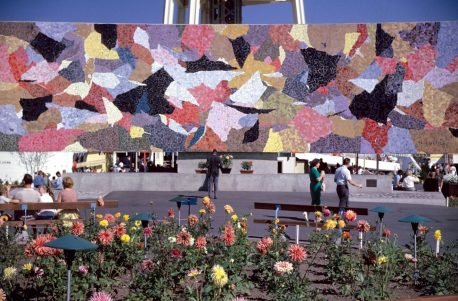Horiuchi Mural Restoration
Written by Leanne Olson
The restoration of the Horiuchi Mural at the Seattle Center was completed during the summer of 2011, thanks to grants from 4Culture and Puget Sound Partners in Preservation/National Trust for Historic Preservation, combined with funding from Seattle Center and the City’s Office of Arts and Cultural Affairs.
The mural, located just west of the Space Needle, is a city-owned designated Landmark that is best known as the backdrop for the Seattle Center Mural Amphitheatre. The Horiuchi Mural, originally named Seattle Mural, was commissioned for the 1962 World’s Fair; at that time, a reflecting pond stood where the stage is now located, as well as a dahlia garden. The concrete backside of the mural was designed by Paul Thiry, who was the supervising architect for the Fair. Paul Horiuchi spent approximately nine months in Italy working on the design for the mural, which was constructed of Murano glass. The 17-by-60-foot mural was shipped to Seattle in 54 square panels and pieced together onsite. The disassembled mural arrived only 10 days prior to the opening of the Fair. According to reports, the installation was complete just moments before the gates opened.
Over the years, the mortar substrate holding the glass in place remained in good condition. However, much of the glass was badly deteriorated, essentially disintegrating from within. Some of the colors were more susceptible to this deterioration than others. In 2006, a pilot treatment study was undertaken on a small section of the mural during which some missing and deteriorated pieces were replaced. Because glass was no longer being manufactured in Italy using the original technique, the replacement glass was sourced locally. The difference cannot be noted from a distance.The goal of the project was to preserve as much of the original mural as possible, while replacing only the missing and badly deteriorated pieces. The timeline for the restoration was very tight. The majority of the work had to be completed over just two weeks in July to avoid conflicting with the busy summer event schedule at the Center. Restorers made a full map of the panels in 22 sections, each of which was mapped in detail to precisely document the restored elements. Patricia Leavengood of Art Conservation Services oversaw the restoration.
References:*September 2021, The Seattle Times Pacific NW: "In celebration out of darkness, Paul Horiuchi's Seattle Center mural inspires a reunion"
September 2021, Clay Eals/Paul Dorpat Now & Then: " Horiuchi Mural, 1965"

